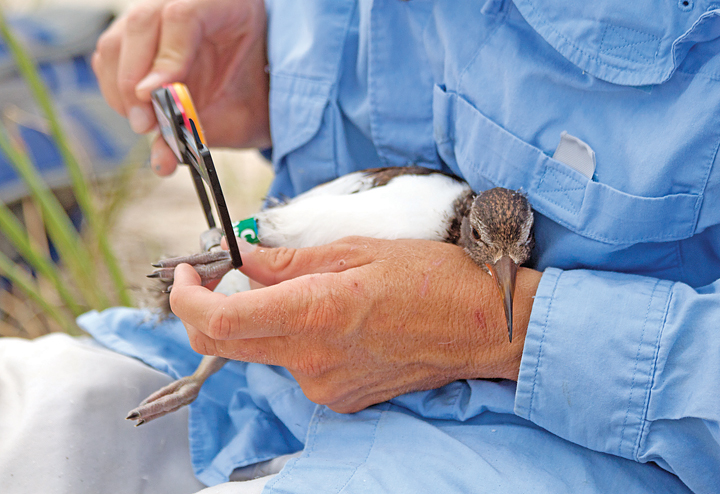Oystercatchers, a species of shorebirds, need a very specific type of environment to raise their young. Masonboro Island provides that, and this year the island’s oystercatcher population is thriving.
Four or five years ago, the island’s oystercatchers didn’t produce any successful fledglings, said Lindsay Addison, Audubon North Carolina coastal biologist. So far this year, the 40 pairs of oystercatchers have produced 24 fledglings.
In order to maintain a healthy population, Addison said, the population should produce about one chick for every two pairs of adults.
“We’re beating that goal,” she said, “and that’s the first time Masonboro Island has done that in quite a few years.”
Oystercatchers are what N.C. Coastal Reserve stewardship coordinator Hope Sutton called an umbrella species, meaning their success indicates the success of other species in the area. The success of Masonboro’s oystercatcher population also indicates the success of North Carolina’s oystercatcher population, because Masonboro provides nesting habitat for 10 percent of the state’s oystercatchers.
“So not only is it important to protect these birds because they add to the special nature of Masonboro Island,” Addison said, “but it’s important to protect them because … if the oystercatchers on Masonboro Island are doing well, the state’s population has a good chance of doing well, too.”
The oystercatchers are thriving because the N.C. Coastal Reserve has removed a few predators, like red foxes, from the island, Sutton said. Red foxes “can live just about anywhere,” Addison added, while oystercatchers are “habitat specialists” that can only flourish in a specific environment like Masonboro.
Even nearby Wrightsville Beach isn’t ideal, she said — she only counted four pairs in Wrightsville’s south end bird sanctuary this summer. Oystercatchers are territorial, not colonial, so each pair needs space to nest, and they eat shellfish like oysters and ribbed mussels, which are plentiful in the marshes near Masonboro.
To better understand Masonboro’s oystercatcher population, N.C. Coastal Reserve and Audubon North Carolina staff members have been banding the fledglings. They visited the island July 12 to band and release two chicks.
They band chicks when they’re about 25 days old — old enough to carry the weight of the band but not old enough to fly, Addison explained, cradling a chick in her hands. She carefully wrapped dark green bands bearing the letters CW9 on the bird’s legs.
No other bird will have identical bands, she said. The banding process makes the birds easily identifiable in the field, and they band both legs because the birds frequently stand on one foot and tuck the other beneath them.
The bands are made from a special plastic that’s durable and doesn’t fade in the sun, Addison said. Through banding the birds, she has learned the population’s demographics and migration patterns.
In addition to Masonboro’s summer population of nesting birds, she said, there are also oystercatchers that migrate to the island from Massachusetts or New Jersey during the winter and oystercatchers that stay on the island year round.
Mellissa Dionesotes, one of Masonboro’s sea turtle monitors, helped Addison band one more chick. After taking a few measurements, they carried the fledglings over to the beach strand and placed them on the sand. After a few moments’ hesitation, the chicks scurried side-by-side in the direction of the adult oystercatcher soaring toward them.
“That’s probably the mom,” Dionesotes said with a smile.
email [email protected]




